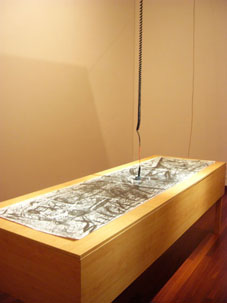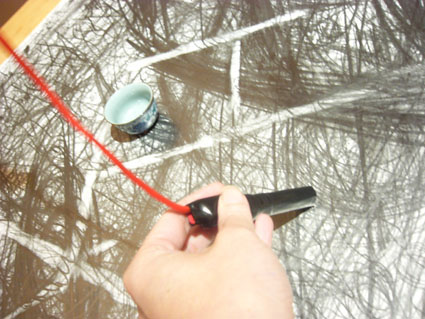 |
Kim Kichul, Sound Drawing |
On the most basic level the work allows you to manifest sound by drawing on the paper. However, if you play with it for a while you discover it also reads the marks that others have made before you. If you're feeling timid and don't want to add to the black squiggles, you can simply "play" previous illustrations. It is even possible to create an instrument out of scrawls, and play your own illustrated noise symphony.
The 6th version of this work exhibited here at MAAP consists of a long strip of paper on a wooden desk with the pen and speakers suspended from above. From Kichul's artist talk as part of the MAAP International Conference we see that there is also a version in which a large vertical wall can be marked and played. That version suggests more performative possibilities—a kind of sonic action painting.
But what does it sound like? AGHHH! It is an aggressive sound palette (even for a sound art devotee) of grating tones and buzzes, ripping and electronic caterwauls. You can achieve a quiet static with a light touch, though the threshold is low and it is very easy to escalate into noise assault. Interestingly, this makes the cause and effect relationship of the work very clear but it also challenges the participant. There is an initial childlike joy in making very loud noises but the consequences are quite difficult to deal with over a sustained period of time. The work is beguilingly simple, with a spiky sonority.
 |
Kim Kichul, Sound Drawing |
Most of Kim Kichul's pieces involve beautifully crafted speakers, and he admits that dabbling in electronics is a hobby. For his work Quartet, he designed small barrel shaped wooden boxes recreating the look of a timber panelled concert hall. Investigating ideas of monaural sound sources, he composed a piece for string quartet, recording each instrument as a separate mono audio channel which he then re-combined through the 4 speakers, emulating concert hall acoustics and challenging ideas as to the fidelity of stereo ("stereo is a lie"). Another multiple speaker work is Hae in—a circle of custom designed speakers positioned around a Korean wooden bell which is self-playing. The mallet is operated by a wheel which lifts it up and then drops it. The gentle tock sounds very similar to the pre-recorded water drops that are triggered randomly from the bell and play across the speaker array.
With a background in the visual arts and sculpture in particular, Kim is self-taught in matters of electronics and audio production. However since 2003 he has been studying Audio Production at the Art Institute of Seattle. He is currently researching his next work which will involve processing voice via a microphone. This time, instead of the voice being amplified through speakers, the sonic material will activate springs and objects fed by the vibrations. MAAP in Singapore–GRAVITY has given Kim Kichul his first opportunity to exhibit outside of Korea, but judging by the conceptual cohesiveness and restrained grace of his practice (and his prolific output), it will not be long before his work is seen by a wider international audience.
Kim Kichul, Sound Drawing, GRAVITY, Singapore Art Museum, curator Kim Machan, 27 Oct - 28 Nov; MAAP in Singapore—GRAVITY, Oct 27-Nov 28
Parts of this article were taken from a conversation between Kim Kichul, Gail Priest and Virginia Baxter, Oct 29.
RealTime issue #64 Dec-Jan 2004
© Gail Priest; for permission to reproduce apply to [email protected]








 back
back